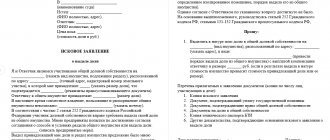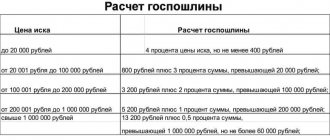Home » Housing disputes » Allocation of a share in kind of a land plot from common shared ownership
6
Almost every citizen of the Russian Federation owns a plot of land, but often such land is in joint or shared ownership. For the use of a land plot, this type of property does not present any problems to its owners, but co-owners cannot dispose of their part without the consent of others.
The way out of this situation will be the physical allocation of a share of the land plot from the total plot of land.
How is a section different from a section?
It is necessary to distinguish between the allocation of land in kind and the division of a land plot (ZU).
Allocation in kind is the allocation of a separate plot of land from common shared ownership. At the same time, according to Art. 11.5 of the Land Code of the Russian Federation, the remaining primary plot will continue to be the property of the remaining co-owners, and the new secondary plot will become the personal possession of the one to whom the share was allocated.
Allocation, unlike partition, is possible only from shared ownership.
The division of a land plot implies the termination of joint or shared ownership of the primary plot and the formation of new independent parts. In this case, the entire territory is divided equally between all owners (or into unequal parts if the shares are not equal) and new secondary shares are created, completely independent from each other. Each secondary plot of land, in accordance with Article 11.4 of the Land Code of the Russian Federation, is assigned its own unique cadastral number.
So, after the allocation of a share, the primary plot remains, only its borders change, and after the division it is actually liquidated, and in its place several new independent land plots are created.
Shape of areas after selection
The most rational shape of a plot of land is a square, other possible shapes in decreasing frequency in practice: rectangle, trapezoid, pentagon and others are found, can be used without problems, and sometimes even have an advantage over a square plot. If the boundary of the original section is broken, then this break will also remain in the allocated lobe if it is cut off from the original section on the side of this break.
The selected and reduced areas will have some of their boundaries in common. This is the most stable type of plot boundary, because when it is agreed upon between the owners, no one has the opportunity to insist on increasing their territory, since the area of the delimited plot is precisely established, and an increase in one plot will immediately reduce the area of another in proportion to the share. That is, if there are 24 acres in a common plot, and three owners each own one-third, then the area of each share is 8 acres.
If you reduce the area of the allocated plot, the size of the allocated share will decrease, and this is unacceptable (with some exceptions).
When a new plot is allocated, it receives a new cadastral number, and the smaller plot from which the share was allocated retains the old cadastral number, but changes its area and boundaries.
Borders will exist:
- In nature, on the site itself.
- On the boundary plan in the form of lines.
- In an electronic file in the form of segments between turning points with given coordinates.
Small kinks do not interfere with the use of the area, especially if they are directed from the inside to the outside.
Why is land allocation needed?
Each co-owner, of course, has his own reasons for allocating a share, of which the three most common are:
- for further sale;
- to give or leave as an inheritance;
- for the construction of any building.
Let's take a closer look at them.
- Sale . So, you own a share of the memory. You do not want to use it for its intended purpose; moreover, you are in dire need of money, but the other co-owners do not want to sell it, and they also do not agree to pay you compensation for your part of the land. What remains? Allocate a share in kind, form a new plot, register it and obtain ownership documents. Now you are free to do whatever you want with your land share, including selling.
- Giving. As mentioned above, after you allocate your part of the land physically, that is, you make an allocation in kind, you can donate it or leave it as an inheritance to any citizen, regardless of the wishes of the former co-owners of the common share of the land.
- Construction. You have decided to add another room to a house that is in shared ownership, or you want to build some kind of building, but the co-owners of the property are against any construction. As long as you only own a share of the property, and the other co-owners do not agree with your decision, you will not be able to do this, no matter how hard you try. Any construction on land that is in shared ownership without the consent of all co-owners is illegal. But, having allocated your share of the plot in kind, you can build a house, a garage, a bathhouse, or add another room to an existing house.
General property
Land of common shared ownership can be used not only for growing crops, for example. Various buildings can be erected on it, which are also registered as common property. How does the allocation of a separate share to one of the shareholders happen in this case?
First, you need to distribute the area of the constructed facility, and then begin the procedure for allocating the site.
If you violate this order, you can get an allotment without part of the building; it will be completely located on someone else’s territory.
Conditions
In order to separate a physically separate property from common shared ownership, certain conditions must be met.
- No significant damage to the primary memory. If the original land plot suffers significant damage, the allocation procedure will be declared illegal, or the remaining co-owners may even prohibit the procedure in court.
- In a situation where part of the land proposed for allocation in the total share of property is too small and cannot be physically allocated, the remaining co-owners are obliged to buy out the allocated share (according to clause 4 of Article 252 of the Civil Code of the Russian Federation). In this case, the amount of the ransom is determined by the court or a settlement agreement.
- Unobstructed passage and passage of vehicles must be ensured to each of the secondary storage facilities. In other words, none of the plots should be located inside others, or be cut off from the road, passage, passage by other plots, or by natural barriers.
- All boundaries of secondary landfills should not have common areas (territorial intersections).
In addition, the legislation determines that the actual size of the newly created ZU does not have to be equal to the ideal share. This can happen due to the characteristics of the landscape, when already during demarcation it turns out that some natural obstacle does not allow the site to be allocated strictly according to the proportion (Clause 5 of Article 13 of Federal Law No. 1001).
For example, on the territory of the primary land plot there is a ravine that divides the territory in such a way that when the land is cut according to the allocated share, several square meters remain near the ravine from the land allotment of other owners, access to which is limited by a natural obstacle (ravine). In this case, the cadastral engineer, of course, will cut this part to the allocated memory.
How does the discharge proceed?
Shares of common property are not always converted into separate plots with ownership rights. Sometimes such an operation is not possible by law. If the created separate memory is small in area, smaller than required by the standards, the action of allocation is impossible.
Therefore, it is recommended to first find out how much area will be transferred to the property, whether it is possible in principle to carry out a transaction with the land, before starting the procedure.
Otherwise, if the shareholder is forced to remain in the form of joint ownership of land that existed before, his relations with other shareholders will be damaged. He will no longer be perceived as a reliable and responsible partner, committed to long-term cooperation.
Even if separation is legally possible, the process will be complex and time-consuming.
- According to the rules, the new site must meet certain requirements. In particular, it must have an area no smaller than the minimum established by law. The minimum area indicator is established by legislative acts, urban planning standards, and may depend on regional laws.
- The next requirement for a new allotment is that the land must retain, even after separation, the category that it had in common ownership.
- The new land plot cannot intersect its boundaries with the share of municipally owned land.
- The separation process itself is necessarily carried out within the framework of the law and does not violate the interests of third parties, the same shareholders.
- Providing an allotment cannot cause property damage to either individuals or legal entities.
- The new allocated area of land must be located so as not to interfere with access to other areas of the remaining shareholders or other owners.
The plot of land, which has been allocated, is now the property of one person. Now the owner will carry out work on this land taking into account his plans, but also taking into account the types of permitted use.
Minimum size of land plot to allocate a share in kind
As mentioned above, the allocation of a share of land in kind, if it is less than the standards established in a given region, is impossible. Article 1182 of the Civil Code of the Russian Federation directly states that a land plot whose value is less than the minimum allowable cannot be registered in the cadastral register, that is, its allocation will be illegal.
In different regions of the Russian Federation, the minimum permissible storage sizes are different. On average, depending on the purpose, the minimum dimensions are as follows:
- gardening purposes - at least 4 acres;
- for country house construction - at least 6 acres;
- for farming - at least 15 acres;
- for private household plots – at least 10 acres.
Thus, if the secondary storage system violates the integrity of the area of the primary one, or its area is less than the minimum allowable, then allocating a share in kind is extremely difficult or even impossible. In this case, the co-owners resort to an alternative way to solve the problem - payment of monetary compensation. In this case, the share remains in joint ownership, and the shares of the property of the remaining co-owners increase.
How to allocate a land plot in kind from common shared ownership
The allocation of a share of memory in kind is possible in two ways:
- by concluding a voluntary agreement;
- through the court.
Of course, the first option is preferable for several reasons:
- voluntary agreement is the fastest way to solve the problem;
- you will not have to bear legal costs ;
- The allocation of the share will take place according to the most optimal option for everyone.
Going to court may be necessary in the following situations:
- the co-owners do not have title documents confirming the right of each to own and dispose of the land plot, in which case they will have to be restored through the court;
- there were errors in the available documents when determining the size of shares, or information about the shareholders, owners, etc.;
- other co-owners do not make contact , that is, solving the problem pre-trial is impossible;
- There are controversial issues regarding the ownership of land plots with the local municipality.
Issues related to allocation
In the legal discourse of agricultural land, the concept of land share is used. The law uses the concept of land share. It should not be confused with a share in a land plot, since a land share is a share in agricultural land.
This share is the only one, transactions with which do not require notarization, while since 2021, transactions with shares in all other real estate properties: apartments, houses, dachas, shops, etc. must be formalized by a notary.
Another issue related to the allocation of a plot is personal income tax (personal income tax) upon its sale and a five-year (previously three-year) tenure period, which exempts the seller of real estate from paying personal income tax. According to the position of the Ministry of Finance, if less than three years have passed from the moment of allocation to the moment of sale, personal income tax is collected, and for plots allocated after January 1, 2021, the minimum period of ownership for exemption from personal income tax upon sale is 5 years.
So, issues related to the allocation of land cover such areas of law as:
- civil law regarding common property;
- registration and cadastral registration;
- features of agricultural land turnover;
- taxation on the sale of new plots.
In each individual case, the answer to questions related to the site depends on the characteristics of the site area, category of land, owner disputes and other factors.
Allocation procedure by agreement
Of course, the allocation of land in kind by concluding a voluntary agreement is significantly simplified, but compliance with the procedure and a certain algorithm is still necessary.
Procedure
You must adhere to the following algorithm:
- Conversation with co-owners . Anyone wishing to allocate a land plot must talk to each of the owners and obtain their consent, determine the size, location of the new plot, and other important conditions of the procedure.
- Carrying out land surveying . If all other owners have given their consent, the person wishing to separate invites a cadastral engineer and pays for his services independently.
- Coordination of the results of demarcation . Each of the co-owners, as well as the owners of neighboring plots, must be familiar with the results of the cadastral engineer’s work. If anyone has objections to the results, their opinion is included in the final document. If there are no objections, a corresponding entry is also made.
- Approval by the cadastral authority . The boundary plan is submitted to the regional cadastral authority, which assigns an address and cadastral number to the newly created land plot.
- Registration of property rights . The owner of the secondary allotment submits an application for registration of ownership rights to Rosreestr; together with the application, he submits the necessary package of documents, on the basis of which an employee of Rosreestr makes changes to the Unified State Register.
Required documents
To register ownership rights to Rosreestr, you must submit the following documents:
- application for registration of ownership;
- passport;
- minutes of the meeting of the co-owners of the primary plot, or written consent to the allocation in kind of each of them;
- cadastral passport for a secondary plot;
- land survey plan;
- extract from the Unified State Register of Real Estate.
Deadlines
The full duration of the procedure depends on the duration of the individual stages:
- reaching an agreement with all co-owners usually takes no more than 2 weeks;
- land surveying work, at least a month;
- registration of property rights - no more than 14 days from the date of submission of the application to Rosreestr.
- Thus, the total procedure time will take two months or more.
Price
The cost of a cadastral engineer’s work depends on the region; on average, you will have to pay from 5 to 30 thousand rubles.
In addition, the owner of a new land plot will need to pay a fixed amount of 2,000 rubles for registering ownership rights in Rosreestr.
Sample agreement
Contents of the agreement on the allocation of a land share in kind:
- Document's name.
- Full names of all co-owners, series and numbers of passports, other contact information.
- Cadastral number and location of the land plot.
- Category put on.
- Information about the title documents for the land plot.
- Data on the sizes of the primary and secondary plots.
- If available, information about the amount of monetary compensation.
- Signatures of all co-owners with transcript.
Sample agreement on the allocation of a share of land in kind
Benefits of equity participation
For many owners, a plot converted from a share of common property into a personal area represents new opportunities and prospects, an opportunity to engage in economic activity at their discretion. But not everyone aspires to become owners.
ATTENTION! Many shareholders are more than happy with joint management, it depends on how the original plan was for the land.
They are quite happy with the consolidation of land for farming, for example, on an industrial scale. You can also build an agro-industrial complex on common land, organize a large farm, or realize other goals.
But you can do some activities on your own and earn a decent income. For example, you don't need a large association to grow poultry or mushrooms.
The procedure for allocation through the court
If the co-owners of the primary land plot could not reach a consensus, the issue of allocating land in kind will have to be resolved in court. As in cases of concluding a voluntary agreement, when resolving a dispute in court, certain procedures must be followed.
Algorithm
The procedure is as follows:
- Establishing the reason why one of the co-owners of the land plot wants to allocate his plot.
- An attempt to resolve the issue pre-trial .
- Obtaining a specialist’s opinion on the possibility of physically separating the storage unit.
- Filing a claim .
- Collection of necessary documents .
- Submission of the statement of claim to the court .
- Participation in court hearings.
- Receipt of a court decision that has entered into force.
- Registration of ownership of a new land plot in Rosreestr.
Statement of claim
Sample statement of claim for allocation of a share of a land plot in kind
A statement of claim for the allocation of part of a land plot in kind is drawn up in accordance with Art. 131 Code of Civil Procedure of the Russian Federation. The document must contain the following information:
- name and address of the judicial authority to which the claim is filed;
- information about the parties to the process;
- cost of claim;
- title of the statement of claim;
- the grounds on which the plaintiff acquired ownership of the land plot;
- information about the land plot (cadastral number, location, size, presence of buildings, etc.);
- the size of the shares of each owner;
- essence of the dispute;
- information about attempts to resolve the problem pre-trial;
- claim;
- list of attached documents;
- date and signature of the plaintiff with transcript.
Required documents
The plaintiff must attach the following package of documents to the statement of claim:
- photocopy of passport;
- title document for land;
- cadastral passport;
- all technical documentation for the memory;
- documents indicating attempts at pre-trial settlement;
- receipt of payment of state duty (required original);
- other documents that can confirm the validity of the plaintiff’s claims.
Deadlines
The timing of court consideration of claims for the allocation of land in kind will depend on many factors, including:
- positions of the parties;
- the need for additional procedures, for example, an assessment examination;
- presence or absence of additional documents;
- other procedural actions.
Typically, the legal battle takes at least two months, but can drag on for up to six months, in some cases longer.
Cost, expenses
The main cost item for such claims is payment for the work of cadastral engineers, and if the plaintiff himself invites land managers, the amount payable will be slightly lower.
For example, calling a cadastral engineer on your own will cost the plaintiff an average of 20-30 thousand rubles, and if land management work is ordered by the court, then their cost can increase to 40-50 thousand rubles.
In addition to the work of the cadastral engineer, the plaintiff will have to pay a state fee. Claims for the allocation of land in kind relate to claims of a property nature, therefore, according to paragraphs. 1 clause 1 art. 333.19 of the Tax Code of the Russian Federation, the amount of state duty can range from 400 to 60,000 rubles.
But, if the court sides with the plaintiff, it may decide to fully or partially recover all legal costs from the defendant in favor of the plaintiff.
Features of free provision
Many families dream of building and living in their own house on their own plot of land. Since 2015, the Russian state has made it possible to obtain a free plot of land for individual housing construction. The following categories of individuals are legally allowed to purchase a plot for individual housing construction:
- large families with three or more children;
- citizens who received land for use free of charge (disabled people, veterans, public sector employees);
- persons covered by local benefit programs.
Land for construction is allocated from the municipal or state fund. The right to grant an allotment can only be used once. The receipt procedure consists of several stages. At the first stage, you need to write an application to local authorities. This can be done through the Multifunctional Service Centers. If the decision is positive, the citizen is registered to receive land.
The majority of the proposed sites are located outside the boundaries of the municipality. You can try to find a plot for housing on your own. If a plot of land has been selected, it is permitted to register it for indefinite use. After several years, the building can be registered as property.
Article 36 of the Housing Code of the Russian Federation establishes the ownership right of owners of residential and non-residential premises in an apartment building to the land plot on which the building itself is located. However, it is impossible to allocate in kind a part proportional to the size of the owners’ shares. This contradicts the condition that it is impossible to establish the boundary of a plot on the ground, since according to Article 42 of the same Code, a plot of land with buildings erected on it and the surrounding area is provided for indefinite use to management organizations.
Arbitrage practice
In each specific situation, the court's decision in favor of one party or another will depend on the circumstances of the case and the situation prevailing at the time of the lawsuit.
There are three possible court decisions:
- Full satisfaction of claims.
- Appointment of an additional examination with a final decision based on its results.
- Replacement of allotment in kind with monetary compensation.
It must be borne in mind that any violation of the judicial procedure or the procedure for filing a claim, as well as the lack of necessary documents, may lead to the court’s refusal to consider the claim.
The law prohibits the allocation of physical shares in cases where:
- There is a threat of damage to the joint storage.
- As a result of the separation, the memory will lose its status.
- There is a risk of violation of the legal rights of third parties.
Example
A plot of land for farming with an area of 30 acres belongs to three co-owners with equal property shares. One of them, citizen Babchenko, decided to allocate his share with the intention of renting it out. Since the land belongs to all three in equal shares, the plaintiff demanded that an area of 10 acres be allocated to him.
But when a land plot of this size is allocated, it loses its status, since plots for farming cannot be less than 15 acres.
The court offered the parties an alternative allocation option - to conclude a settlement agreement between the plaintiff and the defendants on payment to the plaintiff of monetary compensation for his share of the land. The parties agreed with this decision and entered into a settlement agreement.
Based on judicial practice regarding claims for the allocation of part of the land plot in kind, we can conclude that if no encumbrances are imposed on the land plot and there are no legal grounds for refusal, the court will rule in favor of the plaintiff.
Example
Brothers Nikolai and Konstantin Mishchenkov owned a land plot of 15 acres on the basis of shared ownership. Over time, they developed the plot, planted a large garden, erected buildings, but after 15 years Konstantin decided to move to another region and decided to allocate his part of the land in kind for the purpose of its further sale.
But Nikolai was categorically against it, since he felt sorry for his work in arranging the garden and he hoped that his brother would leave him all the land.
Konstantin filed a claim for the allocation of his part of the land plot in kind. The court, having considered all the materials of the case and heard the arguments of the parties, came to the conclusion that the plaintiff’s demands were legitimate, and made a decision in favor of Konstantin Mishchenkov.
The plot was allocated, but Nikolai did not want to part with part of the land plot and bought out his brother’s share.
Despite the apparent simplicity of allocating a land plot in kind, it is quite difficult to take into account all the nuances in each specific case; it is easy for an ordinary person to get confused in legal concepts, laws and regulations.
Our website specialists can help you understand the current situation and provide free advice on the issue that interests you. It will be enough to contact the specialist on duty online, or call the numbers listed below. Our consultants work around the clock.
FREE CONSULTATIONS are available for you! If you want to solve exactly your problem, then
:
- describe your situation to a lawyer in an online chat;
- write a question in the form below;
- call Moscow and Moscow region
- call St. Petersburg and region
Save or share the link on social networks
(
4 ratings, average: 4.75 out of 5)
Author of the article
Natalya Fomicheva
Website expert lawyer. 10 years of experience. Inheritance matters. Family disputes. Housing and land law.
Ask a question Author's rating
Articles written
513
- FREE for a lawyer!
Write your question, our lawyer will prepare an answer for FREE and call you back in 5 minutes.
By submitting data you agree to the Consent to PD processing, PD Processing Policy and User Agreement
Useful information on the topic
2
How to evict your roommate from your apartment
Neither legal nor civil marriages provide guarantees of long and...
3
Is it possible to evict tenants in winter?
Renting out an empty apartment is quite a profitable business, especially...
1
Privatization of land under an apartment building
You can privatize not only a separate residential building, apartment or land...
Privatization of an apartment with debts on utility bills
Debts often become the main reason for refusing privatization, thereby...
4
How much does it cost to privatize an apartment?
Privatization of an apartment is a free procedure, but only within the cost...
Demolition of privatized housing
Any housing, including privatized, under certain conditions...
Litigation regarding the allocation of land plots
All unresolved issues between the owners of the plot about the procedure for allotment and features of use are resolved in court.
As a rule, people go to court in disputes:
- about the area of the allocated plot;
- about its boundaries;
- on compensation for disproportionality of share and area;
- about easement;
- about the rights of other persons.
In legal disputes over land, in addition to the plaintiff and defendant, the following persons usually participate as third parties:
- Administration of the settlement.
- Administration of the municipal district (district).
- Local department of Rosreestr.
Involving these persons, especially Rosreestr, in the process allows us to further eliminate the risk of refusal to register the allocated plot, since the registering authority could express its objections in the case under consideration and, if it expressed them, they were already taken into account by the court when making a decision on the division.
In legal disputes regarding the allocation of a plot of land, an examination is often required.
The examination can offer several options for allocation and indicate their features, which are more and less favorable for the parties. If the allocation of real shares in accordance with the ideal ones is impossible, the expert can calculate the amount of compensation to be paid by the allottee (if he receives more than his share) or in his favor (if he receives less).
Challenging Rosreestr’s refusal to allocate a plot, on the contrary, makes the registration authority a defendant, and co-owners - third parties. In practice, this is a relatively rare case, since the Rosreestr authorities, with all the rigor in their approach to applications for registration of rights, do not impose impossible demands on applicants.











